Good news on California’s efforts to fight climate change: in-state emissions in 2017 (the latest available data) were down over 2016 and ahead of the state’s mandatory 2020 goals. The California Air Resources Board announced the progress yesterday, with this chart showing emissions in context of population and GDP:
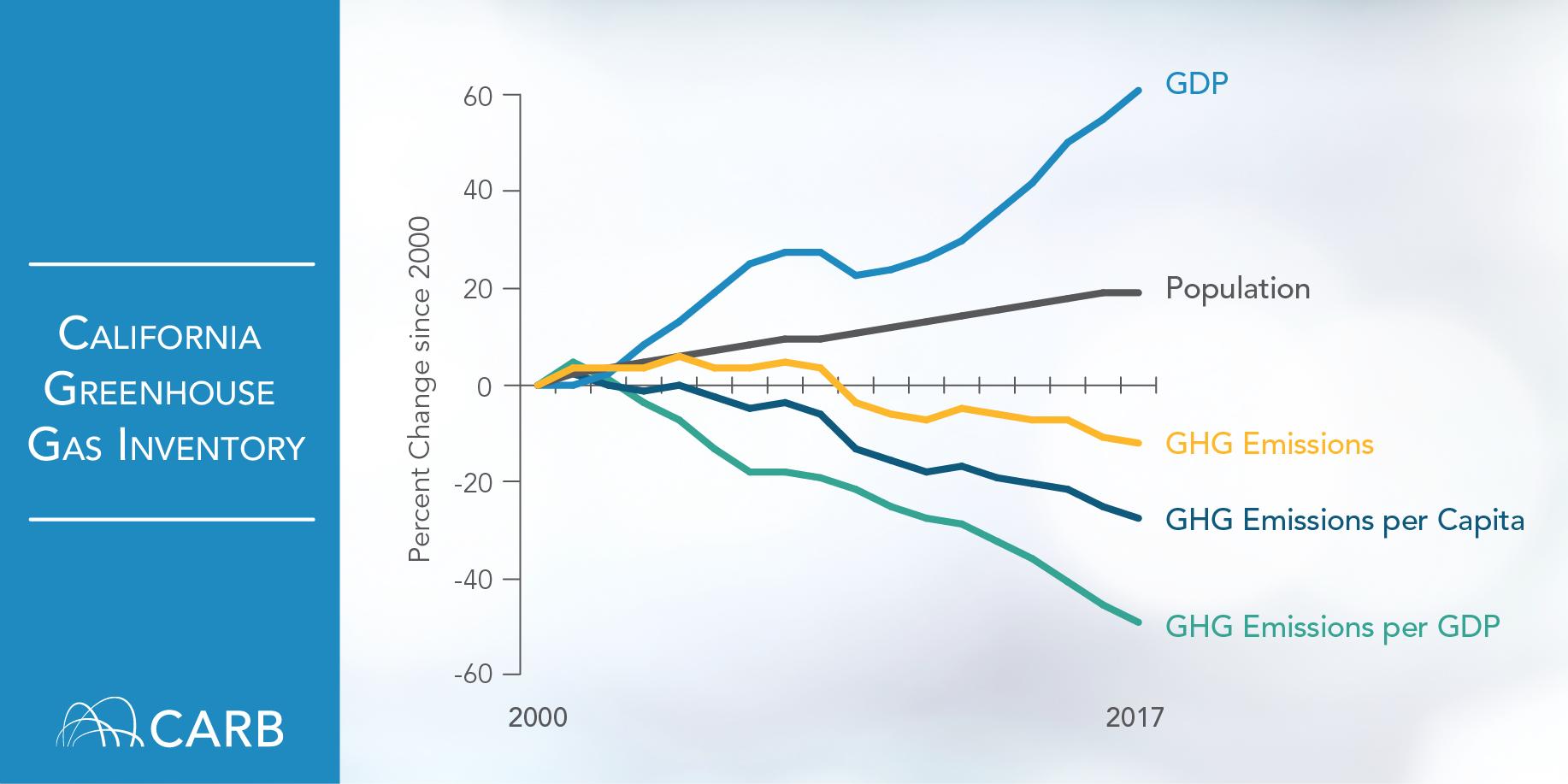
Overall, emissions totaled 424 million metric tons of carbon dioxide equivalent in 2017, down 5 million metric tons from 2016. For reference, the 2020 reduction target is 431 million metric tons.
Most of the progress came from the electricity sector, where for the first time renewable sources made up a larger percentage of the generation than fossil fuels.
However, transportation emissions increased 0.7% in 2017, compared to a 2% increase in 2016, mostly from passenger vehicles. That total is even worse when you consider pollution from oil and gas refineries that make the fuel for these passenger vehicles. Together with hydrogen production, these sources constituted one-third of the state’s total industrial pollution.
Here’s the latest pie chart on where the emissions came from in 2017:
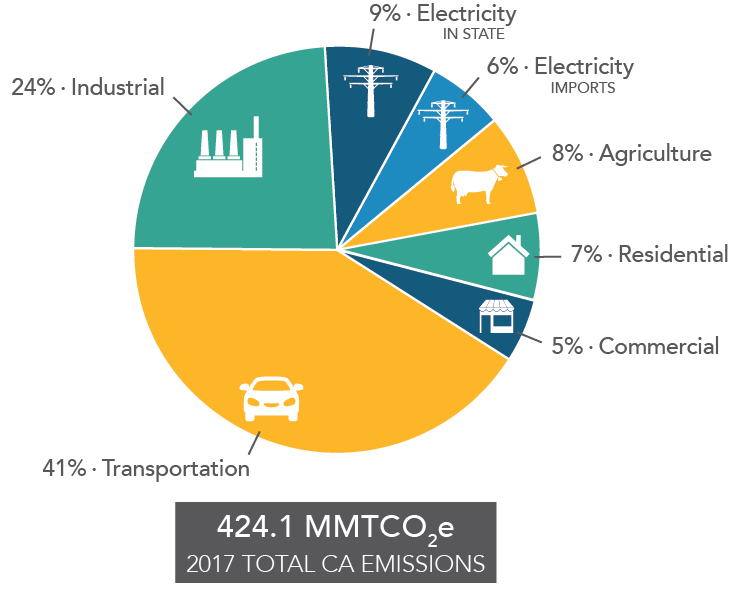
While the story is overall positive for California’s climate efforts, the state will have to redouble its efforts to reduce driving miles by allowing more homes to be built near jobs and transit, while transitioning the remaining driving miles to zero-emission technologies like electric vehicles.
California has already achieved a landmark climate goal, we learned yesterday. Newly released data from 2016 by the California Air Resources Board show that the state’s greenhouse gas emissions decreased 2.7 percent to 429.4 million metric tons.
That number is significant because it’s below the 431 million metric tons the state produced in 1990, which is the level California law requires we achieve once again by 2020. And we’re now four years early on achieving that goal. Since our peak emissions in 2004, California has since dropped those emissions 13 percent.
Much of the reduction is due to significant increases in renewable energy production. Going forward, the next challenge will be a further 40 percent reduction below these 1990 levels by 2030, per SB 32 (Pavley, 2016). And that will require major decreases in emissions from the transportation sector — primarily through greater adoption of zero-emission vehicles.
Importantly, these emission reductions have occurred during a booming economy. The state has effectively de-linked economic growth from carbon-based energy. And all of this economic growth defies industry predictions back in 2006 when the 2020 goal in AB 32 was originally legislated.
As the Sacramento Bee reported at the time during the legislative debates:
[T]he measure [AB 32] is vigorously opposed by the California Chamber of Commerce and the petroleum industry.
”Climate change is real, and we do need to do things,” said Victor Weisser, president of California Council for Environmental and Economic Balance, which represents oil firms. ”But greenhouse gas emissions reduction in California is going to be very expensive.”
In short, industry was not pleased with the climate goals and believed they would cause economic calamity, as another Bee article related:
“We don’t think heavy-handed regulation and bureaucracy is necessary,” said Thomas Tietz, who heads the California Nevada Cement Promotion Council.
Backers say AB 32 would spur new technologies, but Tietz warned that such caps will backfire on the local economy. He said the bill would drive cement producers out of state and force California to import materials produced from countries or states with less stringent environmental rules.
In retrospect, these predictions have not come true. Cement production hasn’t left the state, as industry figures show (although the sector hasn’t fully recovered since the last recession):
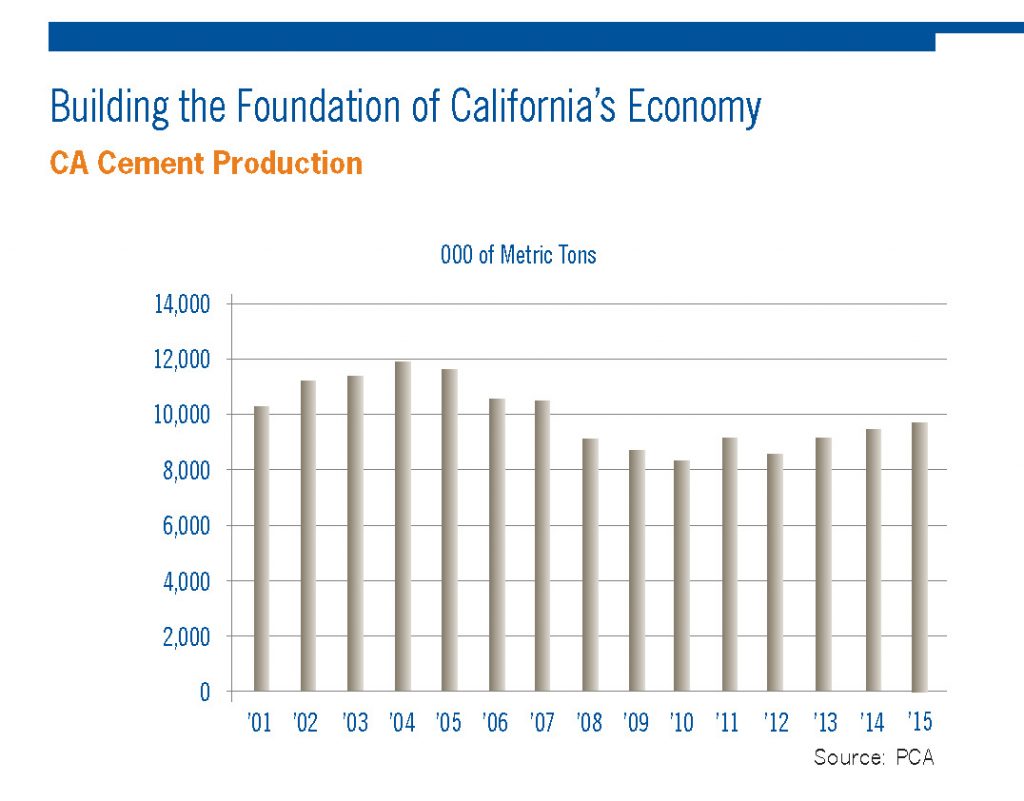 Overall, California’s success is a powerful example for the rest of the world and some important good news in the global fight against climate change.
Overall, California’s success is a powerful example for the rest of the world and some important good news in the global fight against climate change.
With much of the credit due to the proliferation of inexpensive renewable energy, the next challenge will be to ensure similar progress with zero-emission vehicle technology. And given the state’s track record on climate so far, we should be hopeful that similar success is achievable for 2030.
 Climate policies are under political attack, both in California and nationally. The common argument is that these policies hurt the economy and destroy jobs, particularly in disadvantaged communities.
Climate policies are under political attack, both in California and nationally. The common argument is that these policies hurt the economy and destroy jobs, particularly in disadvantaged communities.
To assess those claims, the Center for Law, Energy and the Environment (CLEE) at UC Berkeley Law and UC Berkeley’s Donald Vial Center on Employment in the Green Economy, working with the nonpartisan nonprofit Next 10, released today the first comprehensive cost/benefit study of climate policies in the San Joaquin Valley, one of California and the nation’s most economically and environmentally vulnerable regions.
The Economic Impacts of California’s Major Climate Programs On The San Joaquin Valley specifically looked at the impact of cap-and-trade, renewable energy, and energy efficiency programs in the eight-county region.
Why the Valley? Simply put, if climate policies can work in this region, they can work anywhere. In addition, the region’s elected leaders have asked questions about the impact of climate policies on their constituents, raising their concerns both in the state legislature and now nationally in the congress.
After examining the data and using advanced modeling software, we found that these three programs (among the most important in California’s suite of climate policies) brought over $13 billion in economic benefits to the Valley, mostly in renewable energy, and created over 31,000 jobs just in the renewable energy sector alone.
With the relatively new cap-and-trade program, we found that despite the compliance costs in the heavily industrial Valley, the benefits from state spending of the allowance auction proceeds outweighed those costs, particularly due to construction of high speed rail, which is funded in part with these funds. Furthermore, once the state disburses proceeds already collected from the auction, those benefits will increase greatly.
The overall benefits to the Valley are likely to continue and grow through 2030, as the state strives to meet its newly legislated climate goals for that year, via last year’s SB 32 (Pavley) and SB 350 (De Leon, 2015). Those efforts will require at least 50% renewables by 2030, a doubling of energy efficiency in existing buildings, and a more robust cap-and-trade program.
However, the benefits of cap-and-trade may cease if litigation over the auction mechanism (described by Ann Carlson at UCLA Law) is successful, as that mechanism allows the state to spend the proceeds that provide the benefits. Furthermore, federal action to undercut renewables and energy efficiency could also slow the gains.
Ultimately though, California is committed to its path and these programs through bipartisan legislation and regulations. Given the economic data we see in this study, its a path that the state should continue — and it can hopefully now inform federal debates about environmental policy and the need for job-producing programs.
You can access the full report via CLEE or Next 10’s websites, and check out partial media coverage in the Los Angeles Times, Central Valley Business Times, and Capitol Public Radio.
One of the keys to passing SB 32 (Pavley), the landmark 2030 climate change legislation the legislature approved this year, is that the California economy has thrived since AB 32 (Nunez) passed in 2006. As many climate advocates have noted, despite lowering emissions on a per capita and aggregate level for over a decade, California’s economy is growing at one of the fastest clips in the nation.
All of this economic activity happened despite numerous regulatory and statutory programs to rein in carbon emissions, including cap-and-trade, renewable energy mandates, energy efficiency standards, and the low-carbon fuel standard. And the state is on pace to meet the AB 32 2020 goals, which requires a return to 1990 levels of emissions (about a 15% reduction from business as usual).
In short, this progress has deflated the typical conservative objections to environmental regulations, that they will be economy crushers and job killers. Here’s a summary of the good news, as Debra Kahn reports in ClimateWire (pay-walled):
Meanwhile, California’s economy since 2006 has jumped from the eighth- to the sixth-largest in the world. Yet the amount of greenhouse gas emissions it produces per person, as well as per dollar of gross domestic product, have fallen. Since 2001, state agencies have reported, its carbon emissions per unit of GDP have fallen 28 percent. Last year, the state was home to 68 percent of all clean technology investment nationwide and led in clean-tech patent registrations, as well, according to environmental advocacy group Next 10. And from 2007 to 2015, California outstripped the United States as a whole in job growth and personal income, according to an analysis released in June by Chapman University.
But the celebration shouldn’t get too loud, at least not yet. It’s clear that the state has benefited from some unusual trends that has made it both easier to meet the emissions goals and to grow the economy in a carbon-lite way. First, the economic recession in 2009 put a significant damper on emissions with a slower economy:
“California had a pretty soft economy for many years after its goal was set,” said Severin Borenstein, an economics professor at UC Berkeley and a member of a committee that the California Air Resources Board (ARB) set up in 2012-13 to advise it on the design of its cap-and-trade market. “Although it’s heating up now, we will easily make the 2020 goal, and that will in large part be due to the weak economy for many years.”
Second, the state’s economy has grown in emission-lite industries:
Since 2009, California has lost 1 percent of its manufacturing jobs, compared to 3.7 percent growth in the United States as a whole. During the same period, California’s information services sector grew 10.9 percent, compared to a 1.4 percent decline nationwide, according to Chapman’s June analysis.
We’ve essentially pushed many energy-intensive industries out of state, while benefiting from a boom in services industry like tech, which has made it much easier to meet these carbon-reduction goals.
To be sure, I would also credit the thoughtful, measured approach of many of California’s climate programs and regulations. And of course we have to credit the innovation in the private sector, bringing down the costs of solar PV and batteries and scaling up electric vehicles and low-carbon biofuels, among others.
But as we head into a post-SB 32 world of 40 percent reductions by 2030, the state may not be so lucky with these larger economic trends going forward. It doesn’t mean we should change the approach, but it means we should be honest about what it takes to decarbonize an entire economy and do everything we can to continue bringing down the costs of the technologies that will help us achieve those goals.
Part of the point of AB 32 was to begin the process of “bending the curve” on emissions and clean tech costs. We’re seeing that happen. But to continue on this path through 2030 without costing the economy significantly (and thereby undermining public support), we’ll need further price declines and massive gains in energy efficiency. It’s all doable, but it still remains an open question as to how much and how soon.
Until then, we may need to inject some notes of caution into an otherwise positive picture, so far.
California committed itself last week to the most aggressive greenhouse gas reduction goals in the country. Governor Brown signed SB 32 (Pavley) and AB 197 (Garcia) in Los Angeles on Thursday, placing the state on a pace to reduce emissions 40 percent below 1990 levels by 2030.
The Real News Network interviewed me on Friday to discuss the implications, in a piece airing today:
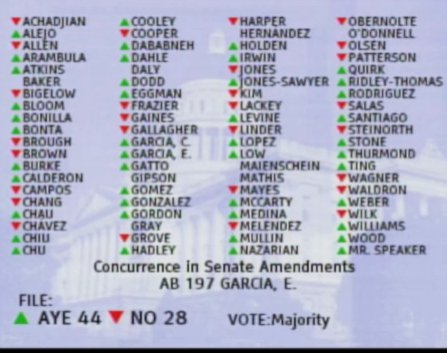
As I noted earlier today, there was a bit of added drama to the passing of SB 32 yesterday in the California Assembly, as the passage was dependent on the state enacting AB 197. The Assembly debated AB 197 this morning, and it passed out of the natural resources committee with six votes in favor and one opposed. It then headed to the assembly floor where it just passed 44 votes in favor, 28 opposed. The governor has vowed to sign it.
The irony is that the oil and gas industry fought attempts in the legislature to save cap-and-trade with a two-thirds vote. Cap-and-trade is a more palatable market-based alternative for the industry, compared to direct regulation, which AB 197 now prioritizes. So the industry is stuck with a majority-vote command-and-control approach. Perhaps then it’s no surprise that industry representatives argued against AB 197 in committee this morning by saying it would undermine cap-and-trade.
So given the political momentum, my guess is that diverse parties now have an incentive to save cap-and-trade. But in the meantime, California has affirmed its international-leading commitment to stay the course on greenhouse gas reductions through 2030, pending final senate approval of an amended SB 32.
As I blogged yesterday, the California Assembly took a giant step in approving SB 32 (Pavley), with one vote to spare for a majority. But the bill is tied to AB 197, which is up for debate today. That bill restricts some of the California Air Resources Board’s independence to implement the 2030 law by giving the legislature more oversight. It also adds in a requirement that all regulations under SB 32 must include a “social cost” accounting that could make command-and-control regulations more palatable than market-based solutions like cap-and-trade. My colleague Ann Carlson at UCLA Law has more analysis at Legal Planet.
The oil and gas industry has apparently targeted AB 197 as a way to bring down SB 32, plus the state senate will need to reconsider SB 32 given that the assembly amended it after it passed the senate first. So it could be another nail-biter.
But assuming these bills are approved in their current form, the implications for California’s post-2020 plans will become much more clear. First, most of the major climate regulations in place now will be able to continue through 2030, without the uncertainty of relying just on an executive order. The big exception is cap-and-trade. However, with command-and-control regulatory authority in place from SB 32, the oil and gas industry will have an incentive to try to re-authorize cap-and-trade as a more palatable alternative to direct regulation. That could make 2017 a big year for that program in the legislature.
In the end, cap-and-trade is just one means to achieving our state’s climate goals, and there are other ways to get there. Command-and-control may be more effective at guaranteeing actual emissions reductions. The downside is that this approach could entail greater costs for industry than a market-based program. And for environmentalists, these site-specific regulations don’t generate auction proceeds like cap-and-trade, which the state is now relying on to fund a host of programs, from high speed rail to low-income housing near transit.
But all of this speculation is premature, as we wait to see what the legislature does with AB 197. I’ll provide updates as the process moves forward.
It was a rough year in 2015 for SB 32 (Pavley), California’s major climate bill to extend the state’s greenhouse gas reduction efforts to 2030. The bill went down without a vote on the Assembly floor, due to opposition from “moderate” Democrats.
But today, the Assembly passed the bill with 42 votes in favor, 29 opposed:
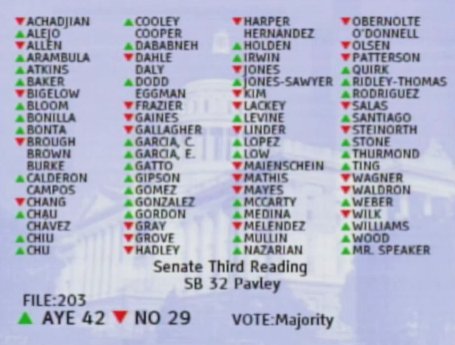
This majority vote won’t inoculate certain programs under AB 32, like cap-and-trade, from court challenges alleging that they constitute a tax requiring a super-majority vote. But the bill gives the California Air Resources Board authority to implement command-and-control regulations, if market-based alternatives are challenged.
With the senate already passing SB 32, the governor will sign soon, and California’s position as an international leader in reducing greenhouse gas emissions will continue.
UPDATE: SB 32 is tied to the passage of AB 197, which is still up for a vote.
As the Sacramento legislature debates SB 32 to formally extend the state’s greenhouse gas reduction targets to 2030, a big piece of the political puzzle is the cap-and-trade program. Namely, will the Air Resources Board have authority to continue the program beyond 2020?
There are a number of scenarios at play:
- The ideal situation, for boosters of the program, is that the legislature approves SB 32 with a two-thirds majority, which inoculates the program from any court challenges that it’s a “tax” or “fee” that requires a two-thirds vote under voter-approved amendments to the state’s constitution.
- Barring that (which seems unlikely this year but could happen next year if an anti-Trump “wave” sweeps away some of the legislators friendly to the oil and gas industry), the next option is to pass the 2030 goals with cap-and-trade via a majority vote. Arguably, the program is neither a tax or fee and therefore only requires a majority vote to enact. But a court would have to decide that outcome. So more uncertainty would result regardless.
- The third option is to simply carry on as usual under AB 32 authority, which the Air Resources Board is currently doing. As my colleague Cara Horowitz at UCLA Law has described, there is a pretty solid argument that AB 32 provides all the authority that the Air Resources Board needs to continue the program beyond 2020, particularly with Governor Brown’s executive order to that effect. But that approach too will almost certainly require a court to sanction, leading to more uncertainty in the coming years.
The final alternative, from a political standpoint, is to pass SB 32 on a majority vote, giving the Air Resources Board authority to issue command-and-control regulations to limit emissions from the oil and gas sectors. Presumably, the industry would much prefer a market-based approach to command-and-control, which would bring them back to the table with their legislative allies to re-authorize cap-and-trade beyond 2020. But who knows. And there’s also the wild card of the governor placing a 2018 ballot measure before the voters on the issue.
One thing for sure: if the legislature does not resolve the situation soon, it will likely fall to the courts to decide.
Since I did the look-back on 2015 yesterday, now’s the time to offer the three big things to watch in 2016 on the fight to reduce greenhouse gas emissions:
3. Presidential Election: This is huge, as the current leading Republican candidate would say. The November election will determine whether the US sticks with the Paris agreement, continues support for renewable technologies and corresponding lack of support for coal, and fights for the EPA Clean Power Plan. The EPA finally released this plan in 2015, as required by a 2007 Supreme Court decision, and the plan underlies the US commitment to greenhouse gas reduction enshrined in the Paris agreement. While the final legal outcome won’t happen for a few more years (it will assuredly go to the Supreme Court), a Republican administration will try to gut the proposed rule from within.
2. Electric Vehicle Progress: As I mentioned yesterday, electric vehicle sales were down in 2015. But with the new Chevy Volt coming out, a slightly improved LEAF, and the much-hyped Tesla Model X all hitting the road, it will be important to see progress on the sales front this year. As a related honorable mention, we’ll need to see continued decreases in battery prices, not just for vehicles but for energy storage more generally.
1. California’s SB 32 2030 Climate Goals: The state has been an international leader fighting climate change, thanks to 2006’s AB 32, which set carbon reduction goals for 2020. But the effort to extend and ramp up the targets by 2030 failed spectacularly in the Assembly last year. It’s vital for the climate fight that the law pass this year. Otherwise, existing legal authorities to continue carbon reduction beyond 2020 are weak, and the signal a failure would send to the country and world would be detrimental. Meanwhile, the state would risk undermining the progress it has made nurturing in-state clean technology industries. While federal action on climate is important, California’s role as the guinea pig and pioneer on climate has been central to showing leaders in advanced economies how to decarbonize while growing the economy.
And with that, let’s see what the new year brings.


